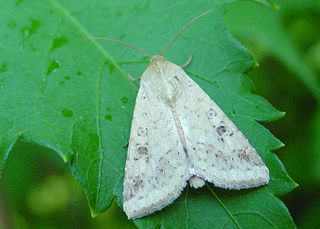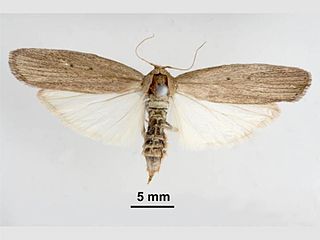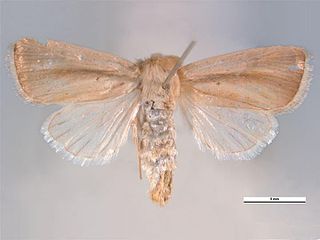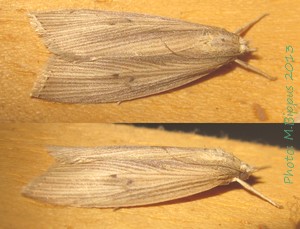
Helicoverpa armigera is a species of Lepidoptera in the family Noctuidae. It is known as the cotton bollworm, corn earworm, Old World (African) bollworm, or scarce bordered straw. The larvae feed on a wide range of plants, including many important cultivated crops. It is a major pest in cotton and one of the most polyphagous and cosmopolitan pest species. It should not be confused with the similarly named larva of the related species Helicoverpa zea.

Penicillaria jocosatrix, the mango shoot borer, is a moth of the family Euteliidae first described by Achille Guenée in 1852. It is found from southeast Asia to the Pacific. Records include Borneo, Guam, Hawaii, India, Sri Lanka, Thailand and in Australia, Western Australia, the Northern Territory and Queensland.

Chilo suppressalis, the Asiatic rice borer or striped rice stemborer, is a moth of the family Crambidae. It is a widespread species, known from Iran, India, Sri Lanka, China, eastern Asia, Japan, Taiwan, Malaysia to the Pacific.

Busseola fusca is a species of moth that is also known as the maize stalk borer. It is known from Ethiopia.

Maliarpha separatella, the African white stemborer, is a species of moth of the family Pyralidae. A worldwide paddy pest, it is found throughout African countries of Cameroon, Mali, Réunion, Madagascar, South Africa, and many Asian paddy cultivating countries such as Myanmar, India, and Sri Lanka. Though they are reported from China and Papua New Guinea, they are also known to attack sugarcane.

Eldana is a genus of moths of the family Pyralidae containing only one species, the African sugar-cane borer, which is commonly found in Equatorial Guinea, Ghana, Mozambique, Sierra Leone and South Africa. Adults have pale brown forewings with two small spots in the centre and light brown hindwings, and they have a wingspan of 35mm. This species is particularly relevant to humans because the larvae are a pest of the Saccharum species as well as several grain crops such as sorghum and maize. Other recorded host plants are cassava, rice and Cyperus species. When attacking these crops, E. saccharina bores into the stems of their host plant, causing severe damage to the crop. This behavior is the origin of the E. saccharrina's common name, the African sugar-cane borer. The African sugar-cane borer is a resilient pest, as it can survive crop burnings. Other methods such as intercropping and parasitic wasps have been employed to prevent further damage to crops.

Tirathaba rufivena, the coconut spike moth, greater coconut spike moth or oil palm bunch moth, is a moth of the family Pyralidae. It is found from south-east Asia to the Pacific islands, including Malaysia, the Cook Islands, the Philippines and the tropical region of Queensland, Australia. They are considered as a minor pest.

Sesamia inferens, the Asiatic pink stem borer, gramineous stem borer, pink borer, pink rice borer, pink rice stem borer, pink stem borer, purple borer, purple stem borer or purplish stem borer, is a moth of the family Noctuidae. The species was first described by Francis Walker in 1856. It is found from Pakistan, India, Sri Lanka, Myanmar to Japan and the Solomon Islands. A polyphagous species, it is a major pest in many crops worldwide.

Scirpophaga incertulas, the yellow stem borer or rice yellow stem borer, is a species of moth of the family Crambidae. It was described by Francis Walker in 1863. It is found in Afghanistan, Nepal, north-eastern India, Sri Lanka, Bangladesh, Myanmar, Vietnam, Thailand, Malaysia, Singapore, Sumatra, Java, Borneo, Sumba, Sulawesi, the Philippines, Taiwan, China and Japan.

Chilo sacchariphagus, the spotted borer, is a moth of the family Crambidae. It was described by Wenceslas Bojer in 1856 and was originally found in South and South-East Asia, where there are three subspecies:

Ostrinia furnacalis is a species of moth in the family Crambidae, the grass moths. It was described by Achille Guenée in 1854 and is known by the common name Asian corn borer since this species is found in Asia and feeds mainly on corn crop. The moth is found from China to Australia, including in Java, Sulawesi, the Philippines, Borneo, New Guinea, the Solomon Islands, and Micronesia. The Asian corn borer is part of the species complex, Ostrinia, in which members are difficult to distinguish based on appearance. Other Ostrinia such as O. orientalis, O. scapulalis, O. zealis, and O. zaguliaevi can occur with O. furnacalis, and the taxa can be hard to tell apart.
Chilo auricilius, the gold-fringed rice stemborer or terai borer, is a moth in the family Crambidae. It was described by Gerald C. Dudgeon in 1905. It is found in India, Taiwan, Bhutan and Sri Lanka, as well as on Sulawesi, Borneo, Sangir Island and the Moluccas. The larvae bore into and feed on the stems of various grass family plants including sugarcane, rice and maize.
Chilo partellus, the spotted stalk borer or spotted stem borer, is a moth in the family Crambidae. It was described by Charles Swinhoe in 1885. It is found in India, Pakistan, Iran, Ethiopia, Lesotho, Madagascar, Malawi, South Africa, Sudan, Tanzania, Uganda and on Mayotte.
Bissetia steniellus is a moth in the family Crambidae. It was first described by the British entomologist George Hampson in 1899. It is found in India and Vietnam where it is commonly known as the Gurdaspur borer because the larvae bore their way into and feed on the stems of sugarcane.
Scirpophaga excerptalis, the white top borer or sugarcane top borer, is a moth in the family Crambidae. It was described by Francis Walker in 1863. It is found in southern Asia from the Indian Subcontinent in the west to southern China in the east, south to New Guinea, possibly Australia and the Solomon Islands.
Sturmiopsis inferens is a species of fly in the family Tachinidae. It is native to Asia and is a parasitoid of various moth species whose larvae feed inside the stems of sugarcane, rice and other large grasses, including the Gurdaspur borer and the sugarcane shoot borer.
Trichogramma japonicum is a minute wasp parasitoid from the Trichogrammatidae family in the order Hymenoptera. T. japonicum parasitizes the eggs of many pest species, especially Lepidoptera found in many monocultures. They are entomophagous parasitoids that deposit their eggs inside the host species' egg, consuming the host egg material and emerging from the egg once development is complete. T. japonicum can be found naturally in rice ecosystems, but are dispersed commercially to many monocultures as a biological control. The mitochondrial genomes of T. japonicum are significantly rearranged when comparing it to related insects.
Naranga diffusa, the rice green semilooper, is a moth of the family Noctuidae. The species was first described by Francis Walker in 1865. It is found in many agricultural based countries such as Bangladesh, India, Sri Lanka, China, Hong Kong, Iran, Japan, the Korean Peninsula, Malaysia, Myanmar, the Philippines, Thailand, Taiwan and Vietnam.










